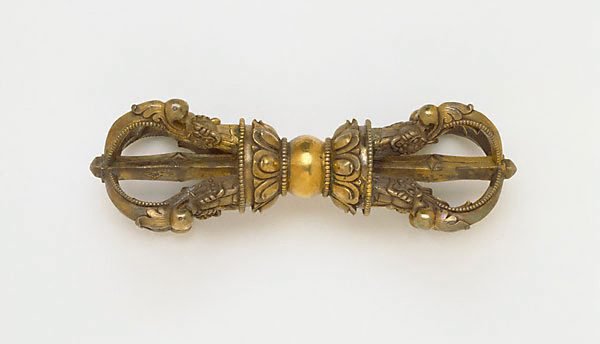-
Details
- Other Title
- Vajra
- Place where the work was made
-
Tibet
- Cultural origin
- Sino-Tibetan
- Date
- 18th century
- Media category
- Sculpture
- Materials used
- gilt bronze
- Dimensions
- 20.0 cm
- Signature & date
Not signed. Not dated.
- Credit
- Gift of Mr F Storch 1980
- Location
- South Building, lower level 1, Asian Lantern galleries
- Accession number
- 9.1980
- Copyright
- Share
-
-
About
A vajra (sanskrit) or dorje (tibetan) is a ritual object symbolising the indestructable nature of the supreme truth
Under Mongol rule (1279-1368) and later again under Manchu rule in the Qing dynasty (1644-1911), Tibet and Mongolia exerted a powerful influence on Chinese Buddhist art, resulting in stylistically distinctive works usually labelled Sino-Tibetan. Buddhism had been introduced into Tibet in the seventh century, and from the thirteenth century Tibetan monks were a constant presence at the Imperial Chinese court. During the Qing dynasty (1644-1911) many members of the royal household were members of the Tibetan Lamaism, a form of Buddhism in which the 'lama' or teacher had enormous power. The 'vajra' (thunderbolt), symbolising the unbreakable Absolute, is the key ritual object in the esoteric Buddhist system of Vajrayana, and is often paired with 'ghanta' (ritual bell). The 'vajra' symbolises compassion and the male, and the 'ghanta' symbolises wisdom and the female. Together they constitute a unity of co-efficients for salvation. Held in the right and left hands respectively, the 'vajra' and 'ghanta' also appear as the attribute of many deities. This unusually large and finely cast 'vajra' has five prongs at each end, five being symbolic of the five "parent" or Dhyani Buddhas who emerged from the meditations of the Supreme (Adi) Buddha whose symbol is the 'vajra'. Each prong emerges from the mouth of a golden 'makara', the mythical aquatic creature that was a popular decorative motif.
'Asian Art', AGNSW Collections, 1994, pg. 205.
The underlying premise of Mahayana Buddhism is that Buddhahood is available to all sentient beings and that spiritual realisation can be achieved through cultivating inherent exemplary qualities like compassion and insightfulness. According to Mahayana understanding, cultivating such ethical perfection is a slow, gradual process that takes place over innumerable lifetimes. Building on Mahayana principles, Vajrayana or Tantric Buddhism, the esoteric branch of the Mahayana tradition, developed a system that focuses on attaining perfection rapidly, within a single life. While the Mahayana path to purification stresses virtuous conduct that involves eschewing desire, sensuality and passion, Vajrayana Buddhists embrace such powerful emotions and use them as radical and unconventional means to attainment. Vajrayana practices include receiving rigorous religious training, undergoing complex ritual initiations and performing transformative yogic meditations.
The ‘vajra’ (Tib. ‘dorje’) is the defining symbol of Vajrayana Buddhism. The Sanskrit term ‘vajra’ is often translated as ‘diamond’ or ‘thunderbolt’, but more appropriately implies that which unfaltering, immutable and brilliant.
The sceptre-like object encapsulates within its symbology the core philosophies of the tradition. It denotes the indestructible nature of Buddhist reality and the adamantine resolve of the individual in quest of this truth. The five prongs of the ‘vajra’, with a central blade surrounded by four in the cardinal directions, symbolise the families of the five Jina Buddhas and the transcendent insights that constitute awakening (see essay p.233). The spherical centre on the ‘vajra’ handle represents Buddhist reality, conceived as ‘shunyata’, or absolute emptiness from which all matter emerges. The two identical ends of the ‘vajra’ denote various dualistic notions like phenomena and noumena; female and male; ‘samsara’ (cycles of rebirth) and attainment; impermanence and permanence. The ‘vajra’ articulates that such seemingly opposing pairs ultimately merge to point to non-dual truth. Often the ‘vajra’ is seen in conjunction with the bell (‘ghanta’), one held in each hand of a deity. In such cases the ‘vajra’ denotes compassion and the bell indicates wisdom (for more on the ‘vajra’, see Beer 1999: 233-243; Huntington and Bangdel 2003:cats 58-59)
Chaya Chandrasekhar, 'Vajrayana' in 'Goddess: divine energy’, pg.226.
© 2006 Art Gallery of New South Wales
-
Places
Where the work was made
Tibet
-
Exhibition history
Shown in 4 exhibitions
Buddhist Art from the Collection of the Art Gallery of New South Wales, Art Gallery of New South Wales, Sydney, 06 May 1995–10 Sep 1995
Goddess: Divine Energy, Art Gallery of New South Wales, Sydney, 13 Oct 2006–28 Jan 2007
Conversations through the Asian collections, Art Gallery of New South Wales, Sydney, 25 Oct 2014–13 Mar 2016
Elemental, Art Gallery of New South Wales, Sydney, 30 Jul 2022–2024
-
Bibliography
Referenced in 9 publications
-
Chaya Chandrasekhar, Goddess: Divine Energy, 'Vajrayana', pg. 226, Sydney, 2006, 226 (colour illus.).
-
Terry Ingram, The Australian financial review, "Buddhas preside over Tibetan art", Sydney, 09 Jan 1992, 20.
-
Jackie Menzies (Co-ordinator), The arts of Buddhism, Sydney, 2001, interior of brochure.
-
Jackie Menzies, Arts of Asia, 'New Dimensions', pg. 54-63, Hong Kong, Nov 2003-Dec 2003, 62 (colour illus.). no.19
-
Jackie Menzies (Editor), The Asian Collections Art Gallery of New South Wales, Sydney, 2003, 62 (colour illus.).
-
Jackie Menzies, AGNSW Collections, 'Asian Art - India, South-East Asia, China, Tibet, Korea, Japan', pg. 173-228, Sydney, 1994, 205 (colour illus.).
-
Jackie Menzies, Three years on: a selection of acquisitions 1978-1981, 'Asian Art', pg. 85-103, Sydney, 1981, 103 (illus.). cat.no. 34
-
Jill Sykes, Look, 'Frederick Storch 1927-2003', pg. 12, Sydney, Feb 2004, 12 (colour illus.).
-
Judith White, Look, 'A landmark for the city', pg. 16-19, Melbourne, Apr 2001, 16 (colour illus.).
-
-
Provenance
Fred Storch, pre 1980, Bellevue Hill/Sydney/New South Wales/Australia, donated to the Art Gallery of New South Wales, Sydney, Jan 1980.
